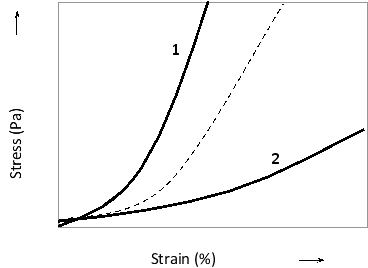The elasticity of the components of the extracellular matrix can be visualized in a stress-strain curve, in which the tensile stress (corresponding to load) applied to a tissue sample is plotted against the strain (corresponding to deformation) measured in the tissue. In the following stress-strain graph, the elasticity of an intact connective tissue is represented by a dashed curve. The other two curves correspond to the same tissue that has been treated with either formic acid (to digest collagen) or trypsin (to digest elastin). Which curve (1 or 2) do you think corresponds to trypsin treatment?

Correct Answer:
Verified
View Answer
Unlock this answer now
Get Access to more Verified Answers free of charge
Q19: In insects such as Drosophila melanogaster, electrical
Q20: You have isolated epithelial cells from mouse
Q21: Which collagens are the most common in
Q22: This large glycoprotein of the extracellular matrix
Q23: Which of the following is true regarding
Q25: Indicate true (T) and false (F) statements
Q26: Neuromuscular junctions of vertebrates are special types
Q27: Indicate true (T) and false (F) statements
Q28: Fill in the blank in the following
Q29: Indicate true (T) and false (F) statements
Unlock this Answer For Free Now!
View this answer and more for free by performing one of the following actions

Scan the QR code to install the App and get 2 free unlocks

Unlock quizzes for free by uploading documents